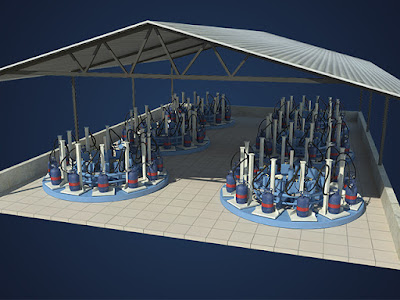A sliding
vane pump has several vanes that can freely slide into or out of slots
in the rotor.
When the pump driver turns the rotor, the vanes move outward
in their slots.
The vanes bear against the inner bore of the casing that
forms the pump chambers.It happens due to the centrifugal force, pressurized
fluid, and rods.
Due to the sliding motion, these pumps offer better
efficiency and less wear and tear.
What is the benefit of sliding vane technology?
It brings optimized performance due to high Volumatic
efficiency and low slippage. Sliding vane pump can
be used in applications at lower viscosity as compared to other positive
displacement pumps.
How is the efficiency of the vane pump calculated?
Experts say that one can experience a drop in efficiency
before replacement. The drop could be as high as 25 percent.
The average efficiency ranges between 50 percent and 60
percent. The more accurately you know the efficiency, the more accurate you can
calculate energy efficiency.
Sliding vane pumps are considered the best to resolve the
pumping system efficiency issues because of their qualities such as low initial
cost, easy installation, and energy cost saving.
Why are Aeplglobe pumps the best?
AEPL is one of the top sliding vane pump
suppliers in India. Every product offered by AEPL is tested and verified
by engineers to assure value for money.
Longer life, quieter performance, and less maintenance lead
to the better running system and efficient energy consumption.
Other pumps are less efficient. Due to the wear of metal
parts, an increase in clearance is prevalent in these pumps.
AEPL makes sliding vane pumps that stand ahead of others in
mechanical efficiency. They are used in a wide variety of industrial
applications.
When the industrial application wants to move liquified
gases, liquid chemicals, or other fluids, sliding vane pumps are ideal.
Due to the constant flow of liquid through the cavity, this
pump can handle heavy volumes.
Outstanding features of AEPL Vane pumps
AEPL makes various models of vane pump suitable for
low-viscosity fluids such as Ammonia and LPG.Due to their lightweight and easy
installation and maintenance, these pumps are preferred by a variety of
industrial users.
·
The company brings the whole array of standard
models such as 55S, 55F, 58S, and 58F with capacities ranging from 50GPM to
90GPM.
·
Based on user requirements, it can make bespoke
pumps up to 350 GPM capacity also. The pumps made by AEPL outshine due to their
high-end technology and precisely machined components. Its unique built-in-pass
arrangement assures an even pressure control.
·
The use of shorter shafts makes AEPL vane pumps
100% vibration-free.
AEPL is one of the recognized andreputed sliding vane
pump suppliers in India. It offers a guarantee of soundless operations and
higher volume efficiency. It is a renowned and reputed pump manufacturer that
follows stringent quality standards.
If you are searching for a superior quality sliding vane pump
that can withstand wear and tear, and offer long-lasting service, then AEPL is the
only choice.
Contact us via mail ales@aeplglobe.in
or call on +91 8097037727/9324907757.






